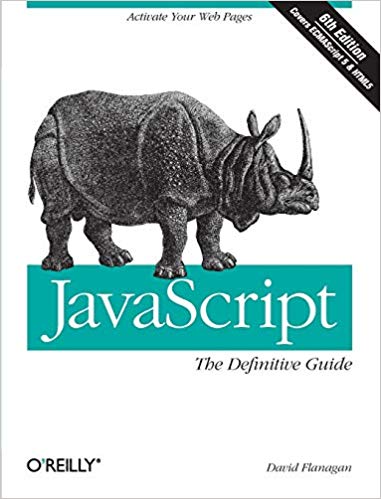An expression is a phrase that can be evaluated to produce a value
Statements are full sentences that end with a semicolon
A function is a named and parameterized block of JavaScript code we define once and can them invoke over and over again
Methods are functions within objects, properties of an object
The 'this' keyword refers to the object on which the method is defined
Variables allow a value to be referred to by name
An array is an ordered collection of numbered values
A function is an object that has executable code associated with it
Constructor: a function written to be used with the new operator to initialize a newly created object
The JavaScript interpreter performs automatic garbage collection for memory management. When an object is no longer referred to, the interpreter reclaims the memory
Strings are an array of characters, they are immutable
JavaScript converts values liberally from one type to another
Variables are untyped
Variables declared outside of a function are global variables and can be accessed anywhere
String methods return a new string, they do not modify the string they are invoked on
Undefined is not initialized or non existant
Null == undefined // true, null === undefined // false
We can copy or compare objects or arrays with for loops
=== does not perform conversions when testing for equality
JavaScript has function scope, not block scope. Let keyword is block scoped
JavaScript objects are compared by reference, not by value
Short circuit: when an expression with && or || stops evaluating based on the first candidate
|| (or) is often used in function bodies to supply default values for parameters
For (variable in object) loops through properties of an object
You cannot rely on a specific order with for/in on object properties
Scope chain: a list of objects that are searched, in order, to perform variable name resolution
The key feature of JavaScript is 'prototypal inheritance.' Each object has a prototype which it inherits properties from
Higher-order function: a function that operates on functions, taking one or more functions as arguments and returning a new function
Memoization: cache previously computed results
Classes define objects that share certain properties
Instances have their own state in properties and behavior in methods
Classes can be thought of as types
Enumerated type: type with a finite set of values
Modules export a public API: functions, classes, properties, and methods
For/each loop is like the for/in loop but it iterates over the values instead of the properties
An iterator is an object that allows iteration over some collection of values and keeps track of the current position in the collection
Next() method returns the next value from the collection
We often don't use iterator object directly, instead, we use iterable objects
You can call Iterator() to obtain an iterator object from an iterable object
You can call the iterators next() method which returns an array with two values, the first is a property name, the second is the value. for (let [k, v] in Iterator({ a: 1, b: 2 }))
Yield is used in generators to return values from a function
Generator: an object that represents the current state of a generator function
Return value of a nonblocking method cannot return the result. We need to provide a function to be invoked when the results are ready or the operation is complete. You can pass a function as an argument
The window object is the main entry point to all client-side JavaScript features and APIs
The document represents the content displayed in the window
JavaScript is commonly wrapped within a window.onload event handler
Web apps use XMLHttpRequest objects to make scripted HTTP requests to obtain new information from the server without a page reload
Embed JavaScript in HTML in 4 ways: 1. inline between script tags 2. external file in src attribute of script tag 3. in HTML event handler attribute, such as on click or onmouseover 4. in a URL that uses JavaScript
JavaScript code in a script is executed once, in order to be interactive, a JavaScript program must define event handlers
If a script defines a new global variable or function, that variable or function will be visible to any JavaScript code that runs after the script does
Defer async on a script tag is used to tell the browser the script won't be generating content and can continue to render the document while downloading the script
Defer is wait until the document is loaded and parsed
Async is run the scripts as soon as possible but do not block document parsing while the script is being downloaded
Events have a name (type, ex. 'click'), and a target (the object on which it occured)
JavaScript is single-threaded so you never need to worry about locks, deadlock, or race conditions
Use setTimeout or setInterval to run subtasks in the background while you update a progress indicator that displays feedback for the user
Web worker: background thread for performing computationally intensive tasks without freezing the user interface
Document.readyState == 'loading' when creating the document object and parsing the HTML elements. Script tags without async or defer are executed synchronously and the parser pauses while the script downloads and runs
When the document is completely parsed, document.readyState == 'interactive'
When all content is loaded and all async scripts have loaded and executed, the document.readyState == 'complete' and the browser fires a load event on the window object
Browser sniffer: code that determines the vendor and vision of the current browser
A JavaScript program can close windows it opened itself
The document object represents the content of the window
DOM is an API for representing and manipulating document content
Query a document for elements with id, name, tag, class, and css selector
A NodeList object that behaves like a read-only array of Element Objects
Nodes are connected in a doubly linked list
In general, to convert between the document and viewport coordinates we must add or subtract the scroll offsets
PageXOffset and pageYOffset help determine the scrollbar positions for the browser window
Viewport size: window.innerWidth and window.innerHeight
Window or element.scrollTop can be set to make the browser scroll
Event types are all lowercase
Within the body of an event handler, 'this' refers to the event target. The single argument is the event object
Like all JavaScript functions, event handlers are lexically scoped: they are executed in the scope in which they are defined, not the scope from which they are invoked
If an event handler returns false, it tells the browser not to perform the default action
All data stored in cookies is transmitted to the server with every HTTP request
Local storage is permanent
SessionStorage exists until the window or tab is closed
Use a manifest file to list all urls that should be cached
Browser online check: navigator.onLine


